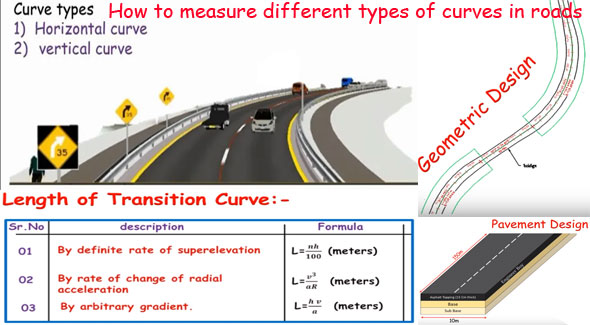How to measure different types of curves in roads
- Concrete Cost Estimator
- Concrete Continuous Footing
- Landscape Bidding and Estimating
- Construction Cost Estimating
- Concrete and steel cost estimation
- Construction Cost Estimate Breakdown
- Construction Estimating Worksheet
- Home Construction Cost Estimate
- Estimate Pricing Sheet
- Sheet for General Contractor
- Construction Cost Estimate
- Labor Materials Cost Estimator
- Masonry Estimating Sheet
- Sheet for Building Contractor
- Construction Schedule Bar chart
- General Cost Estimator Sheet
- General Construction Estimate
- Building and Road Estimating Sheet
- Detailed expense estimates
- Door and Window Takeoff Sheet
- General Construction Cost Estimating Sheet

There are two types of curves in road construction which range from horizontal curve and vertical curve.
Horizontal curve - This type of curve offers a passage among two tangent strips of roadway that facilitates a vehicle to settle a turn at a gradual rate in spite of a sharp cut.
The horizontal curves are categorized as follow : Simple Curve, Compound Curve, Reverse Curve, Transition Curve
Simple Curve - A simple arc is arranged in the road to set a curve among the two straight lines.
Compound Curve - Set of two simple curves which are joined together to curve in the equivalent direction.
Reverse Curve - Set of two simple curves which are joined together to curve in the opposite direction.
Transition Curve - A curve that contains ceaselessly changing radius. It is applied to attach a circular arc to a straight line.
Vertical Curve - A vertical curve offers a passage among two sloped roadways that facilitates a vehicle to settle the elevation rate change at a gradual rate in spite of a sharp cut.
The vertical curve is categorized as follow :- Sag Curve, Crest Curve
Also Read: Building and Road Estimating Sheet
Sag Curve - Sag curve alters the alignment of the road from uphill to downhill.
Crest Curve - It alters the alignment of the road from downhill to uphill.
Length of the circular curve is calculated with the following formula :- L = πRØ / 180
or L = Ø /360 x 2πr
or L = Ø /360 xπD
Here, L stands for the length of a circular curve.
R stands for the radius of a circular curve.
D stands for the diameter of a circular curve.
Ø stands for the central or deflection angle.
Length of the transition curve is calculated with the following formula :-
By definite rate of superelevation
Formula :- L = nh/100 (meters)
By rate of change of radial acceleration
Formula :- L = v3/aR (meters)
By arbitrary gradient
Formula :- L = hv/a (meters)
To get more details, go through the following video tutorial.
Video Source: SL Khan

- Application of concrete calculator
- Roofing Calculator can streamline the roof estimating process
- House construction cost calculator
- Engineering column design excel spreadsheet
- Material Estimating Sheet with Excel
- Materials List and Cost Estimate Worksheet
- Concrete Slab Estimating Calculator Sheet
- Common types of foundations for buildings
- Online calculation of construction materials
- Estimating with Excel for the Small Contractor
- Concrete Beam Design Spreadsheet
- Virtual Construction Management app for construction
- Autodesk’s Project Skyscraper
- Reed Construction’s Reed Insight
- Manage your construction project documentation
- Costimator, the popular cost estimating software
- On Center Software for construction professionals
- Free Construction Estimating Software
- Plumbing Calc Pro
- Cost Estimate Worksheet
- HVAC Piping Quantity Takeoff Worksheet
- Construction Estimating Software Sheet
- Estimate Cost Templates
- Construction Punch List
- Construction cost estimating template consisting estimating basic
- Gantt Chart Template for Excel
- Download Civil Engineering Spreadsheets with Verification
- The Building Advisor Estimating and Budgeting Worksheet
- Spreadsheet for design of concrete bridge
- Construction Estimating Software Free








